Final EAPP Q1 Module 8 - EAPP 11 PDF

| Title | Final EAPP Q1 Module 8 - EAPP 11 |
|---|---|
| Course | hope (P. E)- 11 |
| Institution | Arellano University |
| Pages | 30 |
| File Size | 1.5 MB |
| File Type | |
| Total Downloads | 459 |
| Total Views | 777 |
Summary
Practical Research 2Quarter 1Conceptual Framework:An Illustration of the Research StudySENIOR HIGH SCHOOLEnglish for Academicand Professional PurposesQuarter 1 — Module 8Elucidating a Conceptby Definition, Explication, and ClarificationSenior High SchoolApplied Subject - English for Academic and Pro...
Description
Senior High School
English for Academic and Professional Purposes Quarter 1— Module 8 Elucidating a Concept by Definition, Explication, and Clarification
Applied Subject - English for Academic and Professional Purposes Alternative Delivery Mode Quarter 1 - Elucidating a Concept by Definition, Explication, and Clarification First Edition, 2020
Republic Act 8293, section 176 states that: No copyright shall subsist in any work of the Government of the Philippines. However, prior approval of the government agency or office wherein the work is created shall be necessary for exploitation of such work for profit. Such agency or office may, among other things, impose as a condition the payment of royalties. Borrowed materials (i.e., songs, stories, poems, pictures, photos, brand names, trademarks, etc.) included in this book are owned by their respective copyright holders. Every effort has been exerted to locate and seek permission to use these materials from their respective copyright owners. The publisher and authors do not represent nor claim ownership over them. Published by the Department of Education - Region III Secretary : Leonor Magtolis Briones Undersecretary : Diosdado M. San Antonio Development Team of the Module
Author: Lennie Vi E. Libunao Language Reviewer: Joselito G. Milan Content Editor: Cherilyn R. Goyena, PhD Marciano V. Cruz, Jr. Illustrator: Rolando N. Javier, Jr. Layout Artist: Maica Jill N. De Guzman Management Team Gregorio C. Quinto, Jr., EdD Chief, Curriculum Implementation Division Rainelda M. Blanco, PhD Education Program Supervisor - LRMDS
Agnes R. Bernardo, PhD EPS-Division ADM Coordinator Jay Arr V. Sangoyo, PhD EPS – English Glenda S. Constantino Project Development Officer II Joannarie C. Gracia Librarian II Department of Education, Schools Division of Bulacan Curriculum Implementation Division Learning Resource Management and Development System (LRMDS) Capitol Compound, Guinhawa St., City of Malolos, Bulacan Email address: [email protected]
Senior High School
English for Academic and Professional Purposes Quarter 1— Module 8 Elucidating a Concept
by Definition, Explication, and Clarification
Introductory Message For the facilitator: Welcome to the English for Academic and Professional Purposes Alternative Delivery Mode (ADM) Module on Elucidating a Concept by Definition, Explication, and Clarification. This module was collaboratively designed, developed and reviewed by educators from public institutions to assist you, the teacher or facilitator, in helping the learners meet the standards set by the K to 12 Curriculum while overcoming their personal, social, and economic constraints in schooling. This learning resource hopes to engage the learners into guided and independent learning activities at their own pace and time. Furthermore, this also aims to help learners acquire the needed 21st century skills while taking into consideration their needs and circumstances. In addition to the material in the main text, you will also see this box in the body of the module:
Notes to the Teacher This contains helpful tips or strategies that will help you in guiding the learners. As a facilitator, you are expected to orient the learners on how to use this module. You also need to keep track of the learners’ progress while allowing them to manage their own learning. Furthermore, you are expected to encourage and assist the learners as they do the tasks included in the module. For the learner: Welcome to the English for Academic and Professional Purposes Alternative Delivery Mode (ADM) Module on Elucidating a Concept by Definition, Explication, and Clarification. This module was designed to provide you with fun and meaningful opportunities for guided and independent learning at your own pace and time. You will be enabled to process the contents of the learning resource while being an active learner.
This module has the following parts and corresponding icons: This will give you an idea of the skills or competencies you are expected to learn in the module. This part includes an activity that aims to check what you already know about the lesson to take. If you get all the answers correct (100%), you may
1
What’s In
This is a brief drill or review to help you link the current lesson with the previous one.
What’s New
In this portion, the new lesson will be introduced to you in various ways; a story, a song, a poem, a problem opener, an activity or a situation.
What is It
This section provides a brief discussion of the lesson. This aims to help you discover and understand new concepts and skills.
What’s More
This comprises activities for independent practice to solidify your understanding and skills of the topic. You may check the answers to the exercises using the Answer Key at the end of the module.
What I Have Learned
This includes questions or blank sentence/paragraph to be filled in to process what you learned from the lesson.
What I Can Do
This section provides an activity which will help you transfer your new knowledge or skill into real life situations or concerns.
Assessment
This is a task which aims to evaluate your level of mastery in achieving the learning competency.
Additional Activities
In this portion, another activity will be given to you to enrich your knowledge or skill of the lesson learned.
Answer Key
This contains answers to all activities in the module.
At the end of this module you will also find: References - This is a list of all sources used in developing this module. The following are some reminders in using this module: 1. Use the module with care. Do not put unnecessary mark/s on any part of the module. Use a separate sheet of paper in answering the exercises. 2. Don’t forget to answer What I Know before moving on to the other activities included in the module. 3. Read the instruction carefully before doing each task. 4. Observe honesty and integrity in doing the tasks and checking your answers. 5. Finish the task at hand before proceeding to the next.
6. Return this module to your teacher/facilitator once you are through with it. If you encounter any difficulty in answering the tasks in this module, do not hesitate to consult your teacher or facilitator. Always bear in mind that you are not alone. We hope that through this material, you will experience meaningful learning and gain deep understanding of the relevant competencies. You can do it! 2
What I Need to Know
This module was designed and written for you to master the ways a writer can elucidate on a concept by definition, explication, and clarification.
Various
activities are provided to strengthen your knowledge and skills regarding the topic. After going through this module, you are expected to: 1. define and explain the different techniques used to elucidate concepts in writing a concept paper; 2. show appreciation in characterizing the different techniques; and 3. employ the different techniques in analyzing a text and in writing a concept paper.
What I Know
Directions: Identify the term being described in each item. Write your answers on the space after each statement/question. 1. It is a mode of paragraph development that answers the questions: What is it? What does it mean? What are its special features?”______________ 2. This is the most common form of definition.______________ 3. It is used to define abstract concepts that cannot be formally defined. ______________ 4. It refers to using a similar term or phrase to define a word. ______________ 5. This type of definition explains the origin or the place where the term comes from.______________ 6. This type of definition provides a graphic representation of the concept to be defined. ______________ 7. This definition type means stating what the word or term is for.______________
3
8. This means giving examples or narrating incidences that can further explain an abstract or complicated topic. ______________ 9. This means stating the similarity of one concept with another.______________
10. This means drawing a comparison between the topic and another concept already familiar to readers. ______________ 11. This means defining a term by stating what it is not. ______________ 12. This means defining by the use of opposites. ______________ 13. This entails breaking down wholes into parts, aspects into levels, and a process into steps. ______________ 14. In this type of definition, the writer uses known words or examples to explain an unknown term. ______________ 15. This refers to an explanation or more details something clear or easier to understand.______________
that
make
What’s In
Directions: This is a copy and paste activity. Identify whether each of the statements below characterizes a reaction paper correctly. Place a check mark on the corresponding box of your answer. CHARACTERISTIC
YES
NO
1. It relies on mere suspicions. 2. It is a simple summary. 3. It usually ranges in length from 250-750 words. 4. It presents an analytical response to a book or article.
5. It may take the form of a reflection, an appeal, a protest, a tribute or denunciation, or a speculation If you answered YES to numbers 3, 4, and 5, you are correct! Understanding the characteristics of a good critique or reaction paper is the first step to writing a good paper.
4
What’s New Have you ever heard of the term “window dressing?” You have probably seen the arrangement on window displays outside malls or in stores located along the sidewalk, just like in the first drawing below. If you ’ve seen one, then I must tell you that you ’ve already seen a window dressing. Now, take a look at the second drawing. It also refers to the same thing. What could it probably mean in the world of accounting?
Figure 1. Two representations of the term window dressing
Both drawings refer to the same term but they actually mean two different things, right? The second drawing depicts a misleading representation of data to create a favorable impression. In finance, window dressing happens when financial statements of a company or an organization are prepared to make them look better before they are publicly released. For example, Company ABC wants to attract potential stockholders. It might do some window dressing by making announcements that will likely raise the stock price, like announcing higher than actual sales projections and obtaining and holding a lot of cash. The two definitions of the term are based on how they are used in specific conditions, one in display, the other in finance. While one may think that understanding a term or a concept simply entails defining it, then he/she must change the way he/she thinks. Several techniques are used to better elucidate or explain a concept and they will be discussed in this lesson. Students are often asked to submit academic papers as a subject requirement. Some students find writing these types of paper a difficult thing to do. Why? A study conducted by Pablo and Lasaten (2018) showed that 227 Grade 11 Senior High School students in the Schools Division of Laoag City have difficulties in writing academic essays. The said difficulties stem from a number of factors which include use of incorrect word and word usage. This can be attributed to poor elucidation skills of students. According to Merriam Webster, to elucidate means to make something clear or understandable. In writing an academic paper, concept elucidation is a critical tool. Why? Because getting the message understood by your reader is the primary concern of any written text. And if you fail in clarifying a concept, you fail to express your understanding of it. So what are the techniques that one can use to effectively elucidate a concept? 5
Elucidating a Concept by Definition, Explication, and Clarification I.
DEFINITION
Definition is a “mode of paragraph development that answers the questions: What is it? What does it mean? What are its special features? ” (Saqueton and Uychoco 2016, p.80) When you define a word, idea or concept, you clarify its meaning and you control the scope to avoid misinterpretations and vague ideas.
The word to be defined may be a person, a place, an object, a concept, or an event/ phenomenon. There are different techniques used in defining a term or concept. 1. Formal definition
This is the most common form and follows a pattern: Term = genus + differentia or
Definition = general category + differentiating characteristics Examples:
Term
=
genus
+
differentia
a. A triangle is a plane figure with three straight sides and three angles. b. A measuring cup is a cup-shaped utensil used to measure dry and liquid ingredients for cooking. It is important to limit the genus. The narrower the genus, the more specific the definition will be. 2. Extended definition It is used to define abstract concepts that cannot be formally defined. The following are the strategies you can use for this particular technique: A. Use of synonym: using a similar term or phrase to define a word Examples: a. A charlatan is a quack, an imposter, a pretender, a fraud.
b. A bloke is a man, a boy, a fella, or guy in British. Synonyms are only useful when a reader is more familiar to the meaning of the word being defined than the actual term itself. B. By etymology: explaining the origin or the place where the term comes from.
Examples: a. Tyrannosaurus rex comes from the Greek word meaning “tyrant” and “lizard” and the Latin word meaning “king”. b. Eskwela is from the Spanish escuela and the Latin schola, which means “conversations and the knowledge gained through them during free time; the places where these conversations took place.” C. By illustration or visuals: providing a graphic representation of a topic or term to be defined.
6
Examples: 1. The water cycle describes the continuous movement of water from the surface of the Earth, to the atmosphere and back again.
Figure 2. A visual representation of the water cycle
1. A mattock is farm tool used for removing stones and large roots.
Figure 3. A mattock
D. By function: stating what the word or term is for. Examples: 1. A straight spatula is a kitchen tool used for scraping food from the sides of pots, stirring ingredients in curved bowls, or folding ingredients into each other. 2. A ledger is a written or computerized records of all the
7
transactions a business has completed. E.
By examples: giving examples or narrating incidences that can further explain an abstract or complicated topic. Examples: 1. Compound exercises are exercises that require multiple muscle groups to work at the same time, like deadlifts, squats, front lunge with twist, and high plank T-spine rotation. 2. The horticulture industry can be categorized into three areas: pomology, olericulture, and ornamental horticulture.
E.
By likeness or similarity: stating the similarity of one concept with another. Examples: 1. Brighter than 100 million suns, quasars stand like beacons on the shore of the universe. 2. A teacher is like a gardener who allows the students to grow under the best conditions.
G. By analogy or metaphor: drawing a comparison between the topic and another concept already familiar to readers. Examples: 1.
The central processing unit (CPU) of a computer system works like the human brain.
2.
Life is like a box of chocolates - you never know what you're going to get.
H. By negation: defining a term by stating what it is not. Examples: 1. The Philippine flying lemur is not a lemur but a rodent, and cannot fly as it only glides in the air from one tree to another.
2. In a vehicle with automatic transmission, the driver is not responsible for shifting the gears as the car does the shifting. I.
By contrast: defining by the use of opposites. Examples: 1.
Unlike other birds, penguins cannot fly.
2. Unlike other mammals, the duckbilled platypus doesn’t give birth to live young. J. By analysis or partition: Breaking down wholes into parts, aspects into levels, and a process into steps. Examples: 1.
The Philippine government is divided into the executive branch, the legislative branch, and the judiciary. 8
2.
For a definition of diabetes, the writer would want to partition the three kinds of diabetes (type 1 diabetes, type 2 diabetes, and gestational diabetes) and discuss them one at a time rather than try to define them all at the same time.
3. Informal definition
In this type of definition, the writer uses known words or examples to explain an unknown term. Examples: a. Freedom, also referred to as liberty or independence, is a state people reach when they are free to think and do whatever they please. b. Bullying occurs when someone uses his or her power or prestige to intimidate and terrorize another person.
II. CLARIFICATION Cambridge Dictionary defines clarification as “an explanation or more details that makes something clear or easier to understand.” In reading and writing, you can use several strategies to clarify a point and avoid misconceptions or miscommunication. 1. Through Cause and Effect: Understanding the relationship between cause and effect is a critical thinking skill essential in all aspects of life. We consider how mining is related to deforestation and wildlife loss. In history, we try to understand the causes and effects of specific political events in the country that affect the way we view science and religion. A cause is the reason why something happens while the effect states the result or the outcome. A causal chain is a sequence of events in which any event in the chain causes the next one, leading up to the final effect. Let us analyze the sample text below. Minamata disease (M. d.) is methylmercury (MeHg) poisoning that occurred in humans who ingested fish and shellfish contaminated by MeHg discharged in waste water from a chemical plant (Chisso Co. Ltd.). It was in May 1956, that M. d. was first officially “discovered” in Minamata City, south-west region of Japan's Kyushu Island. The marine products in Minamata Bay displayed high levels of Hg contamination (5.61 to 35.7 ppm). The Hg content in hair of patients, their family and inhabitants of the Shiranui Sea coastline were also detected at high levels of Hg (max. 705 ppm). Typical symptoms of M. d. are as follows: sensory disturbances (glove and stocking type), ataxia, dysarthria, constriction of the visual field, auditory disturbances and tremor were also seen.
Further, the fetus was poisoned by MeHg when their mothers ingested contaminated marine life (named congenital M. d.). The symptoms of patients were serious, and extensive lesions of the brain were observed.
9
While the number of grave cases with acute M. d. in the initial stage was decreasing, the numbers of chronic M. d. patients who manifested symptoms gradually over an extended period of time was on the increase. For the past 36 years, over 17,000 people from Kumamoto and Kagoshima prefectures have claimed to have been Minamata disease victims. Of these, 1,408 have passed away, but even before the official discovery of Minamata disease, caused by Chisso Company, many had died from it. In 1964, Minamata disease also broke out along the Agano River in Niigata prefecture, where the Showa Denko Corporation used the same production process. Elsewhere in the world, damage to hea...
Similar Free PDFs
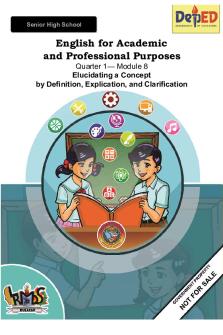
Final EAPP Q1 Module 8 - EAPP 11
- 30 Pages
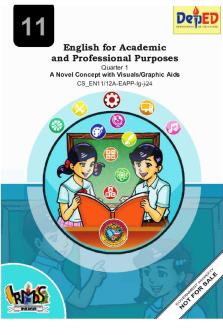
Final EAPP Q1 Module 10 - EAPP 11
- 24 Pages
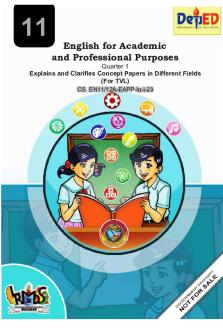
Final EAPP Q1 Module 9 - EAPP 11
- 22 Pages

EAPP- Q1- Module 5 - english
- 23 Pages

EAPP-Module-2 - Module
- 28 Pages
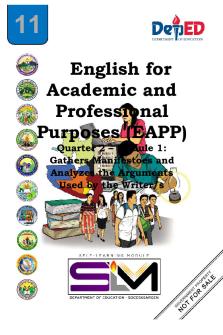
EAPP- Q2- Module 1 - english
- 22 Pages

EAPP Quarter 2 Module 5
- 70 Pages

EAPP Q2 Module 5 - Research
- 20 Pages

EAPP- Q2- Module 5 - english
- 20 Pages

EAPP TG - Research
- 207 Pages
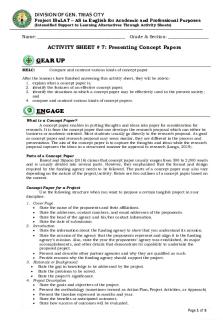
EAPP Q3-AS8-Concept Paper Final
- 5 Pages

Remedial sa EAPP GR
- 2 Pages

EAPP-O.C.-summative-q2-
- 2 Pages

EAPP Quarter-1-WEEK-1
- 19 Pages
Popular Institutions
- Tinajero National High School - Annex
- Politeknik Caltex Riau
- Yokohama City University
- SGT University
- University of Al-Qadisiyah
- Divine Word College of Vigan
- Techniek College Rotterdam
- Universidade de Santiago
- Universiti Teknologi MARA Cawangan Johor Kampus Pasir Gudang
- Poltekkes Kemenkes Yogyakarta
- Baguio City National High School
- Colegio san marcos
- preparatoria uno
- Centro de Bachillerato Tecnológico Industrial y de Servicios No. 107
- Dalian Maritime University
- Quang Trung Secondary School
- Colegio Tecnológico en Informática
- Corporación Regional de Educación Superior
- Grupo CEDVA
- Dar Al Uloom University
- Centro de Estudios Preuniversitarios de la Universidad Nacional de Ingeniería
- 上智大学
- Aakash International School, Nuna Majara
- San Felipe Neri Catholic School
- Kang Chiao International School - New Taipei City
- Misamis Occidental National High School
- Institución Educativa Escuela Normal Juan Ladrilleros
- Kolehiyo ng Pantukan
- Batanes State College
- Instituto Continental
- Sekolah Menengah Kejuruan Kesehatan Kaltara (Tarakan)
- Colegio de La Inmaculada Concepcion - Cebu

![[ Amaleaks. Blogspot.COM] EAPP-111 Week 1-7](https://pdfedu.com/img/crop/172x258/qk2qo1ppzqrw.jpg)